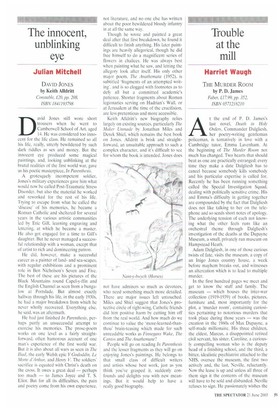The innocent, unblinking eye
Julian Mitchell
DAVID JONES by Keith Alldritt Constable, 1:20, pp. 208, ISBN 1841193798 David Jones still wore short trousers when he went to Camberwell School of Art, aged 14. He was considered too innocent for the life class. He remained so all his life, really, utterly bewildered by such dark riddles as sex and money. But the innocent eye produced some magical paintings, and, looking unblinking at the brutal realities of the first world war, gave us his poetic masterpiece, In Parenthesis.
A grotesquely incompetent soldier, Jones's military experiences gave him what would now be called Post-Traumatic Stress Disorder, but also the material he worked and reworked for the rest of his life. Trying to escape from what he called the 'disease of his memories, he became a Roman Catholic and sheltered for several years in the various artistic communities led by Eric Gill, learning engraving and lettering, at which he became a master. He also got engaged for a time to Gill's daughter. But he never managed a successful relationship with a woman, except that of artist to rich and domineering patron.
He did, however, make a successful career as a painter of landand sea-scapes, with regular exhibitions and a prominent role in Ben Nicholson's Seven and Five. The best of these are his pictures of the Black Mountains round Capel-y-ffin and the English Channel as seen from a bungalow at Portslade. But almost exactly halfway through his life, in the early 1930s. he had a major breakdown from which he never wholly recovered. Everything else, he said, was an aftermath.
He had just finished In Parenthesis, perhaps partly an unsuccessful attempt to exorcise his memories, The prose-poem works on one level as a fairly straightforward, often humorous account of one man's experience of the first world war. But it is also about all wars as seen in The Iliad, the early Welsh epic Y Gododdin, Le Morte &Arthur, and Ilemy V. The soldiers' sacrifice is equated with Christ's death on the cross. It owes a great deal — perhaps too much — to James Joyce and T. S. Eliot. But for all its difficulties, the pain and poetry come from his own experience,
not literature, and no one else has written about the poor bewildered bloody infantry in at all the same way.
Though he wrote and painted a great deal after that first breakdown, he found it difficult to finish anything. His later paintings are heavily allegorical, though he did free himself to do a magnificent series of flowers in chalices. He was always best when painting what he saw, and letting the allegory look after itself. His only other major poem, The Anathemata (1952), is subtitled 'fragments of an attempted writing', and is so clogged with footnotes as to defy all but a committed academic's patience. Shorter fragments about Roman legionaries serving on Hadrian's Wall, or at Jerusalem at the time of the crucifixion, are less pretentious and more accessible.
Keith Alldritt's new biography relies largely on existing sources, particularly The Maker Unmade by Jonathan Miles and Derek Shia which remains the best book on Jones, Alldritt is brisk and straightforward, an unsuitable approach to such a complex character, and it's difficult to see for whom the book is intended. Jones does not have admirers so much as devotees, who need something much more detailed. There are major issues left untouched. Miles and Shiel suggest that Jones's protective circle of right-wing, Catholic friends did him positive harm by cutting him off from the real world, And how much do we continue to value the 'more-learned-thanthou' brain-teasing which made for such unreadable works as Finnegans Wake, The Cantos and The Anathemata?
People will go on reading In Parenthesis and the lesser fragments as they will go on enjoying Jones's paintings. He belongs to that small class of difficult writers and artists whose best work, just as you think you've grasped it, suddenly confounds and delights you with new meanings. But it would help to have a really good biography.


































































































 Previous page
Previous page